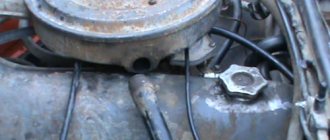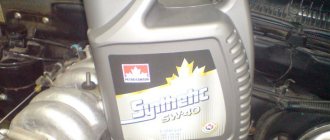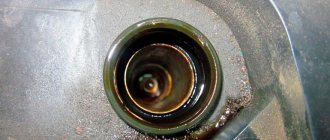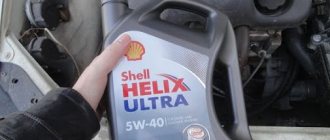Owners of Lada Priora cars often experience increased oil consumption. The role of motor oils in engine operation is very important. One of the main tasks is the formation of a film with low friction coefficients on the surfaces of rubbing surfaces. Lubricating fluids also cool the elements of the piston group and timing mechanism. Oil transports carbon deposits and metal particles to the filter. Many owners would like to know why the Priora consumes oil. Let's look at why this happens and how to fix it.
What is increased consumption
By the term “eating oil”, car owners mean increased consumption of lubricating motor fluids.
Often, during normal operation, such waste should not occur - the standards established by the manufacturer will be observed if there are no problems. If the technical documentation for the car states that replacement should be carried out once every 10 thousand kilometers, and the driver has to top it up more often, then this is an increased consumption.
Why is lubricant quickly used up?
"Priora", despite its modern engine, "eats" a lot of oil. The reasons for this are as follows:
- the appearance of a leak;
- wear of spare parts;
- low quality motor oil;
- exceeded operating period;
- burning of oil liquid.
Often, car oil leaks occur due to poor crankcase ventilation. This happens because the exhaust enters the crankcase through the piston rings. Gases create increased compression, which disrupts the normal flow of processes in the unit. The oil is simply squeezed out of the engine.
Why do Priors eat oil, besides the reasons listed above? Oil is probably leaking from the valve plug or oil filter. To eliminate such leaks, the lining must be replaced. Constant vibration exposure, high loads, trips over rough terrain - all this causes various leaks.
Synthetics have good viscosity characteristics, ensuring the uninterrupted functioning of all units. It contains many additives that soften and partially eliminate the consequences of the negative impact on the power unit.
Mineral water does not have the advantages of synthetics. It pollutes the lubricating complex with its own combustion products. As a result, it turns out that the car “eats” oil.
An excessive operating period may also be the reason that the machine eats oil. Since the characteristics of the motor oil deteriorate during operation, some of the lubricant evaporates and burns out.
This negatively affects the car engine. Timely measures taken will allow the power unit to operate without failures for a long time.
Where does it go?
The correct operation of internal combustion engines largely depends on whether there is a sufficient amount of lubricants inside. Oil, as noted above, is necessary to reduce friction between the rubbing surfaces of parts. The most intense friction is in the parts of the cylinder-piston group. Since high temperatures are constantly maintained in the engine, some of the oil burns out in the cylinders and is then removed along with the exhaust gases. Also, part of the lubricating fluid settles on the cylinder walls, on valve seats, and on oil scraper piston rings.
Increased consumption, complaints from drivers that the Priora is consuming oil - this is a sign that the engine has one or more malfunctions. Most often, the reason is very banal - it is natural wear and tear of the CPG. The first call is oil in the crankcase ventilation system. This happens due to high gas pressure in the crankcase. This pressure will increase as the engine wears out.
Oil requirements for Priora
Motor oil determines the efficiency and longevity of the engine. The types recommended by the manufacturer are given in the operating manual for the Lada Priora car - semi-synthetic with parameters SAE 5W-30 or SAE 5W-40 from Rosneft or Lukoil. Along with brands of domestic manufacturers, the following brands have proven themselves well: Mobil, MotulSpecific DEXO s2, Shell HELIX HX8, Castrol.
When choosing the right brand, you should take into account the climatic zone of operation, the age of the car, driving style and your own purchasing power.
Increased oil consumption in Lada Priora is associated with a number of factors: leaks through seals, oil seals, gaskets and other places where there is a loose connection of parts, including the oil filter. Along with this, the problem can be caused by wear of the piston rings, which causes oil to penetrate into the combustion chamber. Clogged crankcase ventilation system, aggressive driving style and poor quality lubricants can also cause an increase in engine oil consumption.
Oil consumption rates for Lada Priora
The car can be equipped with one of four engines. Each modification has its own expense. Thus, an 8-valve 1.6-liter engine with a power of 87 horsepower should consume up to 50 grams per thousand kilometers according to standards. The VAZ-21126 model with a power of 98 horsepower should also, according to the manufacturer, have modest appetites. The 1.8 liter model (VAZ-211128) has an oil consumption rate of 300 grams per thousand kilometers.
For 1.6 units, the oil consumption rate does not exceed 50 grams. The latest engine is modernized. Its key features are that with a standard cylinder block, the developers changed the stroke of the pistons by using a different crankshaft and shorter connecting rods. This technical solution led to increased loads on the engine, or more precisely on the pistons, rings, cylinder block walls and connecting rods.
In some cases, if the engine is severely worn out, the Priora consumes up to 3 liters of oil per thousand kilometers. Let's look at the main reasons for increased oil appetite in a car.
Oil waste
The car can “eat” consumables due to burnout. This is due to the fact that the oil indicators do not correspond to the characteristics of a particular engine. An excessively liquid oil product will remain in the cylinder block and burn out. And if it is too thick, it will envelop the moving parts with a dense film, significantly complicating their movement.
All this will lead to increased oil costs. In view of this, you need to use only the lubricant recommended by the car manufacturer.
Severe burnout can occur due to worn valve seals. Identifying this problem is quite difficult. To prevent the lubricant from smoking, that is, to stop burning, the seals need to be replaced. The piston rings also need to be changed. If they wear out significantly, engine repair may be required.
Reasons for increased consumption
Several can be highlighted. The most common is wear of the valve stem seals. They are installed in the gas distribution mechanism.
Problems with caps should be solved very carefully, despite their simplicity. So, these elements are made of rubber - it can harden. This probability increases significantly if the engine does not warm up well. “Priors” with high mileage often suffer from this. The cuff (if it is frozen) will not be able to fit tightly into its seat - because of this, the oil will enter the valve sleeve without any obstacles. As a result, the lubricant will enter the cylinders, where it will burn safely. Oil can also get into the exhaust system. There will be characteristic blue smoke.
Oil leak through breather
Oil loss through the breather is a very unpleasant problem. A breather is a device that compares the crankcase pressure of a power plant with atmospheric pressure. Without it, air would not get into the engine at all. Reasons for this malfunction:
- Air filter condition. The engine simply doesn't have enough air.
- Filling the lubrication system above a certain level. The excess is simply squeezed out through the breather.
- Worn oil scraper rings. As a result, excess pressure appears in the engine crankcase, which expels oil through the breather.
If the first two faults are easy to deal with, then the third one will have to go to a service station. Very rarely, the oil deflector rod may become clogged. In this case, gasoline and oil vapors do not pass into the oil separator, but are deposited in the breather, and a characteristic smell of gasoline is present.
Rings
The Priora consumes oil not only because of the caps. The second most common problem is the piston rings. Each of the pistons, and there are four of them in a car engine, has three rings. Two of them are compression, and the third (lowest) is an oil scraper.
Automakers use compression rings to reduce the distance between the piston and cylinder. This ensures maximum energy transfer. To reduce friction, compression rings are lubricated. This oil should then be removed by the oil scraper ring. If the latter is worn out, then it is not surprising that the Lada Priora is burning oil.
If the ring is worn, it will not be able to remove oil from the cylinder walls. As a result, the lubricant will enter the combustion chambers, where it also burns safely.
The car constantly heats up/cools down over its entire service life. Naturally, huge loads fall on every component and part in the engine. If the elasticity or wear of the piston rings has decreased, then this may be the cause of an interesting phenomenon - flutter. Little is known about it yet; this phenomenon has not yet been well studied. But during engine operation, the rings rotate around the piston at certain speeds. In doing so, they can even jump from one edge of the piston groove to the other. In fact, this reason is revealed even more often than ring wear when there are complaints that the Priora burns oil but does not smoke. Although a clear sign of increased oil consumption is blue smoke from the exhaust pipe.
Engine oil waste is the most common cause of losses.
Synthetic motor oil reduces consumption.
Increased oil consumption may also be a consequence of the combustion process. This fact may be due to a discrepancy between the parameters of the lubricating fluid and the characteristics of a particular engine. Oil of too low viscosity will remain in the cylinders and burn, and an excessively dense substance can envelop all moving elements in a film of increased density, which will significantly impede their movement. Both of these options will ultimately lead to increased oil consumption. Therefore, based on the technical recommendations issued by the Lada Priora manufacturers, you should use the required type of lubricant or high-viscosity oil from recommended industrial companies.
Switching from synthetic oil to a synthetic blend oil can also solve your oil consumption problem. Since the composition of such products practically does not differ in their set of components, semi-synthetics contain additional additives and compensators that make it much more practical to use, so that it does not lose its properties. It simply does not penetrate into places where it may be exposed to abnormally high temperatures.
Severe oil loss can also be caused by worn valve seals. Diagnosing a problem like this is quite difficult. This can only be done based on indirect compression values. Replacing the seals can completely neutralize combustion. In this case, worn piston rings also need to be replaced, otherwise, due to their wear, the need to repair the engine may very soon arise.
If there are signs that the Lada Priora is “eating” oil, you need to conduct a thorough diagnosis of all systems and try to identify the problem. In most cases, the reason lies in the above factors. Therefore, their localization and neutralization is the most important task to ensure uninterrupted engine operation. Replacement of some parts and subsequent monitoring can become prerequisites for reliable and durable operation of the machine.
Engine oil leaks are common in high mileage vehicles. If the motor begins to consume lubricant above normal, this is an alarming symptom. The reasons for this may be different. After analyzing the diagnostic results, you will learn how to fix the problem. The lubricating fluid may disappear inside the engine - when it is running, it is clear that the engine is smoking.
Low quality oils
One of the reasons for increased consumption is the low quality of this same oil or the wrong choice. For each engine, including the Lada Priora, there are certain tolerances. But if you make the wrong choice, your consumption can skyrocket. For example, reduced viscosity can cause the rings to fail and collect lubricant from the cylinder walls. Therefore, the lubricant will settle on the walls of the combustion chamber and, as a result, will burn along with the fuel.
As a result, exhaust gases will come out in the form of bluish smoke, and the oil will settle as soot on the spark plugs. For the same reason, the rings become coked. Oil settles in a very thick layer on engine parts and components.
Troubleshooting Methods
The first thing to do is to find possible leaks by carefully inspecting the valve cover. If there are leaks on the engine oil pan, drain the oil, then unscrew the pan and change its gasket, preferably placing it on sealant. If there is a leak through the crankshaft seals, replacing them yourself will be very problematic. It is better to carry out repairs at a service station.
Another reason for increased consumption may be a clogged crankcase ventilation system. Over time, resin deposits and carbon products are deposited on the walls of the pipe, which makes it difficult to remove gases that have escaped from the combustion chamber. This creates excess pressure in the crankcase, which forces oil through the seals and seals. Oil mist will enter the combustion chamber in excess through the ventilation system and intake manifold, which will lead to a decrease in the calorific value of the fuel and loss of engine power. To prevent this problem, it is necessary to regularly clean the ventilation system pipes: approximately every 50 thousand kilometers.
You should be careful about the quality of the lubricants used. They must comply with those recommended by the manufacturer, taking into account the climatic zone of the vehicle's operation. By following all the necessary recommendations, eliminating the indicated malfunctions and abandoning an aggressive driving style, you can significantly reduce the consumption of fuel and lubricants in your car.
Natural wear and tear
If the Priora engine consumes oil, then most likely the engine has a high mileage, and the reason for oil consumption is the natural wear and tear of the engine itself and its individual components. As a result, oil will be consumed much faster than during normal operation. Engine wear can also be the cause of cylinder deformation, cracks, gasket burnout, and failure of engine seals. Motor oils can be deposited in engine parts and components, but it can be difficult to determine how large the excess consumption is. It depends on how worn out the engine and other systems in the car are.
How to change the oil mixture in Lada Priora
If the car’s warranty has already expired and there is no need to carry out scheduled maintenance at the dealer, in Lada Priora you can change the engine oil yourself. This process is simple. You just need to follow a certain sequence of actions. You must purchase in advance a 4-liter canister of motor fluid with suitable properties, as well as an oil filter. If you are going to switch to a different viscosity or change manufacturer, you will additionally need to flush the engine.
Soft flushes, according to the conditions of their use, are poured 200–300 kilometers before changing the lubricant. During this time, they clean the engine of toxins. Others pour right before you change the oil. Then the engine idles for 5 minutes to half an hour. It all depends on the specific wash. You should prepare: your own set of wrenches, a container for used lubricant, rags.
- The engine warms up well, the car is placed on a lift or over an inspection hole.
- The filler neck under the hood is released. The drain plug is carefully unscrewed with a 17 key, and a container for draining is first placed in the bottom of the crankcase.
- The old oil is completely drained along with the flush. It is advisable to suck out the remaining lubricant from the bottom with a large syringe with a tube - after all, it is very difficult to park the car in an absolutely horizontal position.
- The old oil filter is unscrewed. A new one is installed, half filled with new grease.
- The drain plug is screwed in and about 3.5 liters of lubricant flows into the engine through the filler neck. The level is checked with a dipstick; it should be halfway between MIN and MAX.
- The engine starts and idles. After 5–7 minutes, the oil level is checked again. Top up if necessary.
Your car is ready to travel again until the next consumable replacement.
Reason #1
If, after the engine has been idling for several minutes, you press the gas pedal to the floor several times, a thick cloud of bluish smoke may escape from the chimney. As the number of presses increases, the smoke will disappear, but this is one of the signs of engine malfunction. The reason is the valve stem seals.
An oil leak while the engine is running in idle mode and then its sudden combustion in the cylinders leads to the appearance of this thick smoky cloud and an increase in oil consumption. But replacing the caps cannot always solve this problem. Sometimes, if a Priora consumes oil, the reasons may be in the valve bushings. Experts recommend changing them along with the valve stem seals.
What if it doesn't help?
You will have to do a major overhaul, restoring the geometry of the cylinders and replacing the pistons. A “capital” is also necessary if the engine turns out to be worn out when opened. Otherwise, in the future you will pay more money for repeated repairs and liters of oil that will need to be added.
- How to extend the life of the motor is described here.
- Car accessories “Behind the wheel” - the choice of experts!
- A fire extinguisher for a car is not just a requirement of the traffic police, but a guarantee of safety for the driver and his passengers.
8 ways to reduce oil consumption. No engine overhaul
Reason #2
Sometimes smoke appears when climbing a hill, because you have to constantly press the pedal. The driver may not see the smoke, but those driving behind will see everything perfectly. A thin stream of smoke is a sign of malfunctions in the piston system, as well as increased oil consumption.
Most often, malfunctions are associated with wear of the piston rings and grooves on the piston for the rings. Also, the rings can lie down and, as a result, their properties are lost. If the compression rings are not positioned correctly due to carbon deposits, this is also one of the faults that causes blue smoke.
Cylinders can also fail. This leads to a decrease in compression. This problem can only be solved with the help of a major overhaul - sleeve or boring. If the pistons fail, the problem can be solved by purchasing and installing new ones.
Many novice car owners ask experienced ones what to do, the Priora is burning oil. You can try using engine decarbonizers.
With the help of special means, the coke is cleared from the rings, and they can become mobile again. Previously, for this, acetone diluted with oil and kerosene was poured into the cylinders. The mixture was then left for a day and then the oil was changed. If this solution does not help, then you can try a miracle drug from the pharmacy - dimexide. This medicine will clear away any carbon deposits and coke.
Recommendations
Comments 74
I have it too, but I don’t worry, I saw a video on YouTube that some kind of sensor or something in the air duct is clogged, so it starts pouring oil in there little by little, the solution is to clean this crap and everything will be smooth, but I’m too lazy ))
I also use oil, although the compression is good and the engine has done 87,000 and all my friends have the same thing. I was initially told, if you want a Priora with a 126 engine, have a personal oil station, ,. I top it up and don’t worry. It’s just reasonable and long-term I haven't found a solution to this problem yet...
I’m also leaning towards a bushing or a connecting rod, and I have great doubts from such professional craftsmen as they described for me here... pull out the block? A duralumin box? + its upper part rests against the block... something new...
I love the capital, there is a used original piston assembly with low mileage, I can give it away for cheap
I have a 2014 Priora, so the service book says oil consumption is 800g. per 1000 km. In the summer, 15,000 km (according to the regulations) from oil change to oil change lasts for me, with about 800 g of top-up for the entire period. In winter, when there is slipping and high speeds, I add about 4-5 liters per cycle. Mileage currently 60,000 km. so you still have normal oil consumption. and before that there was a 2110 with a 2112 engine converted to a 124 engine so there was no consumption
87025311866 Ruslan. Call him and talk to him, he’s an excellent mechanic!
there was such a thing, only the oil was bigger than yours... the engine was capitalized, but you can only change the oil scraper rings, that’s what they do in the services, but they take the money as if it were capital, , , but they themselves only install rings of larger diameter
Priora 16 valve. Mileage 91,400 km. After changing the oil, I drove 2000 km and added 600 grams.
ehh, the 124 has a 150t mileage engine and the same problem...yesterday I changed the oil and filled in the Hado decarbonizer...maybe it will help...and so, another 10 thousand and I’ll make a capital investment...on the Priora spg no problem...
There was the same problem at the same mileage, I changed the MSK and the Rings, drove 10 thousand and everything started again, the oil consumption was 1 liter per 2000 km, the last time I filled it with Lukoil 5W40, when the next time the oil ran out on the dipstick, I added semi-synthetic 10W40 to due to what remained in the crankcase and the oil burn is not yet noticeable. But after the burnout, detonation appeared, and I also found oil in the receiver, despite the fact that the throttle and air intake were dry. It felt like it was being thrown through a small ventilation branch.
Should I change the oil if the consumption is high?
Often, car owners, after identifying increased consumption, ask themselves the same question - do they need to change the oil completely every time or is it enough to add fluid from time to time as consumption occurs? Some motorists believe that it makes no sense to perform a complete oil change in this case. During the period, the same amount of lubricant will pass through the engine as if a replacement were being performed.
A complete replacement, in fact, must be carried out in accordance with technical service books and documents. The main function of oil is to reduce friction between rubbing parts and clean the engine. Debris settles in the pan or in the oil filter. But dirt is not removed from the engine. During operation, the amount of carbon deposits will increase, and constantly adding new oil will only compensate for the amount of dirty oil.
Such a liquid will always have a dark color. Therefore, it needs to be changed every 10 thousand, and together with the filter. Otherwise there is a risk of coking.
Motor oil and its main functions
The technical documentation of the car clearly states the required consumption of oil and other consumables.
The technical documentation of each car indicates specific figures for the consumption of a particular fluid used by the vehicle’s systems. Motor oil is no exception to this list. However, sometimes problems arise in the operation of the car, one of which is increased oil consumption.
Motor oil is an important part necessary for the full and efficient operation of all systems. Not a single mechanical system, such as an engine, can fully function without lubricating fluids. During operation, many interconnected mechanical processes occur in the motor. As a result, friction occurs between the moving elements, which has a destructive effect on the parts of the motor and its functionality. Motor oil is designed to compensate for all the negative effects caused by friction and prevent functional wear of parts.
A decrease in oil level or its increased consumption leads to the fact that moving parts cannot fully perform their functions due to insufficient lubricating fluid. Parts begin to wear out, and mechanisms jam and fail. Therefore, monitoring the oil level and its quality is the most important task to ensure continuous and long-lasting operation of the vehicle.
Violation of the tightness of sealing joints in the form of oil seals or gaskets
The appearance of oil from under the valve covers or cylinder head gasket. Where oil leaks, it mixes with dust and forms a characteristic coating. There can be several reasons for a leak:
- Failure of the gasket itself, since the product is rubber. The repair is not difficult, but requires care when tightening the bolts.
- The appearance of oil under the gaskets is caused by an increase in pressure in the engine lubrication system. There may be four reasons here:
- The first and most important is the failure of the oil pump pressure reducing valve, which maintains the pressure within certain limits. It can only be repaired by replacing this device.
- Second, use very viscous oil. Do not skimp on oil; fill in the oil specified in the service book by the car manufacturer.
- Third, clogged oil channels (for worn engines). Occurs when using various flushing liquids of dubious purpose (meaning “decarbonization”).
- Fourth, a violation of crankcase ventilation, in which gases accumulate under the valve cover and oil pressure begins to increase, oil appears in the air filter. Cause: The separator screen is clogged and needs to be cleaned.
- The appearance of oil leakage from under the seals. There are three reasons for this malfunction:
- First, the oil seal simply wore out over time.
- Second, the pressure in the car’s lubrication system is increased.
- The third option is the hardest. The rotating parts of the power unit wear out in the form of bearings, rings, half rings, etc. In this case, the alignment of the units is disrupted and the parts become distorted. There is no need to replace the oil seals in case of this malfunction; this will only give a temporary effect. The intervention of an engine repair specialist will be required.











